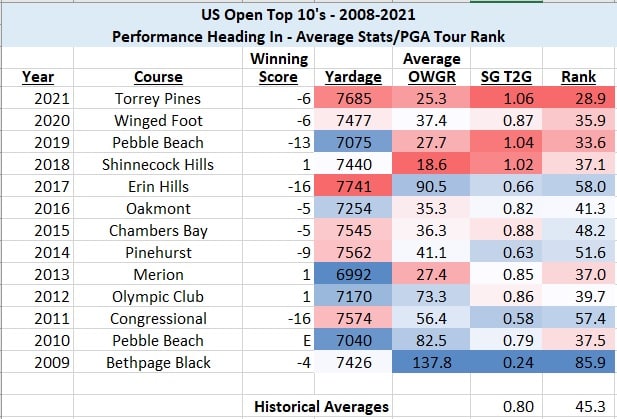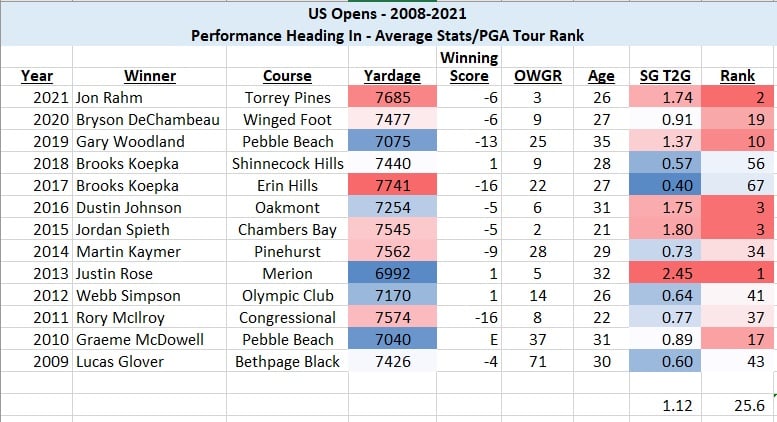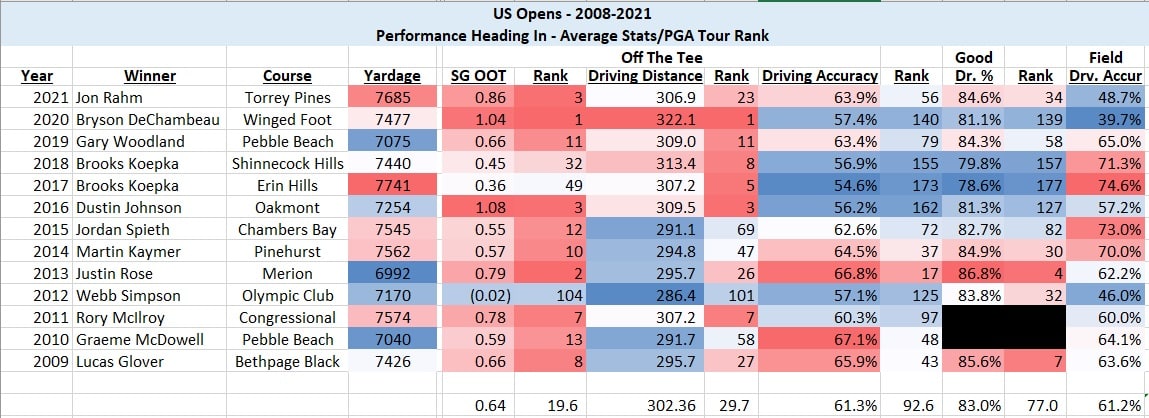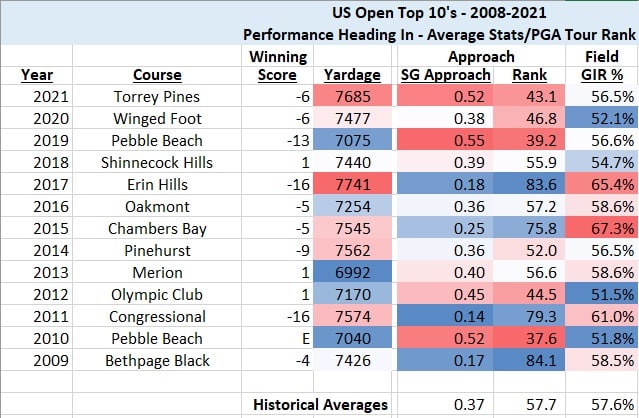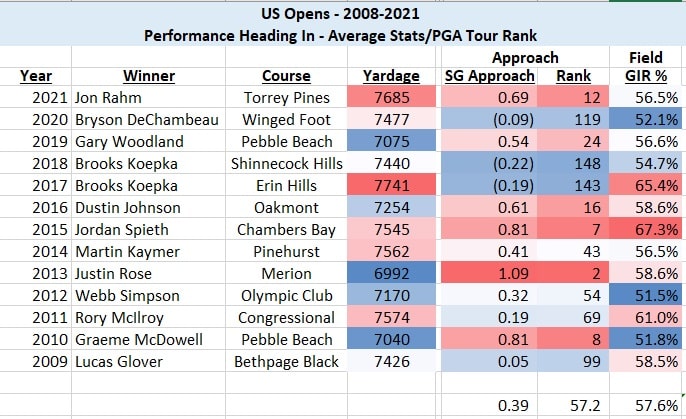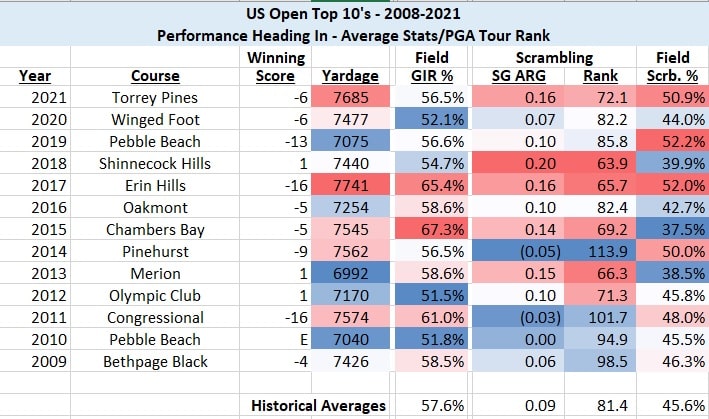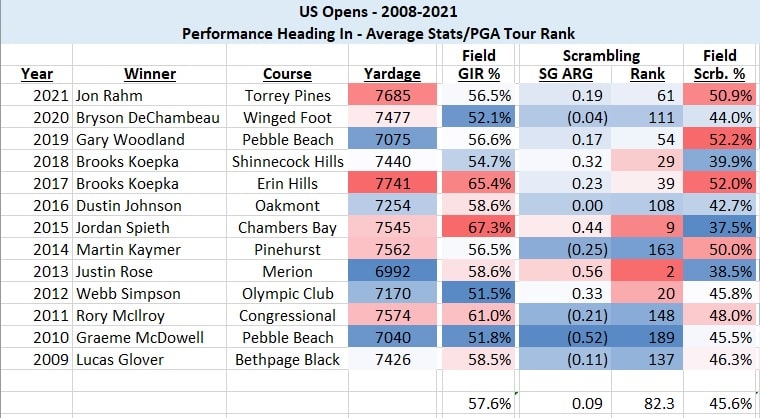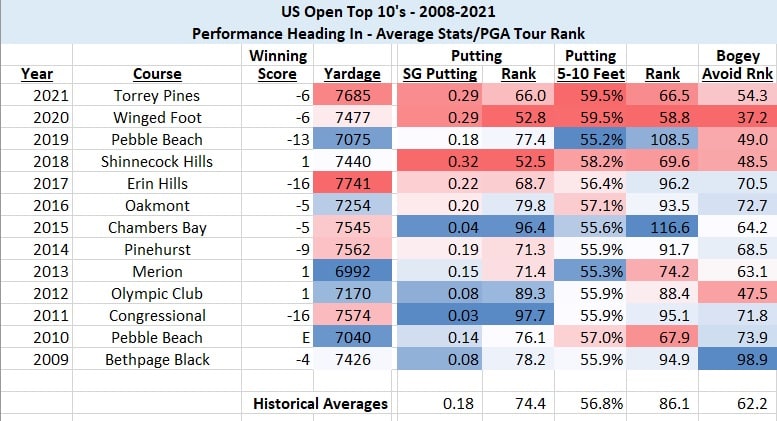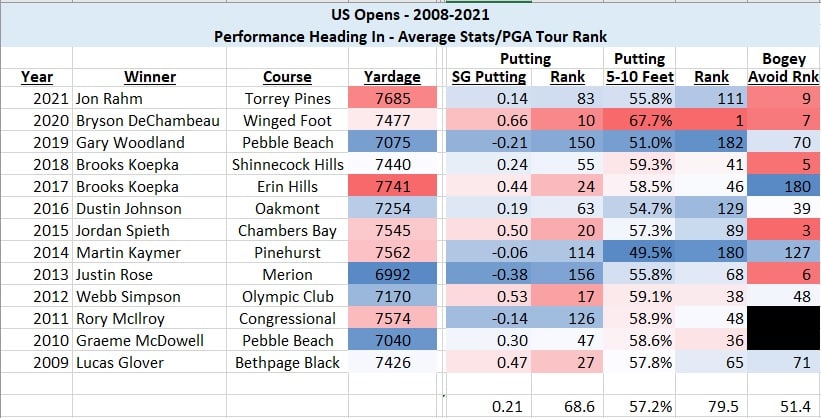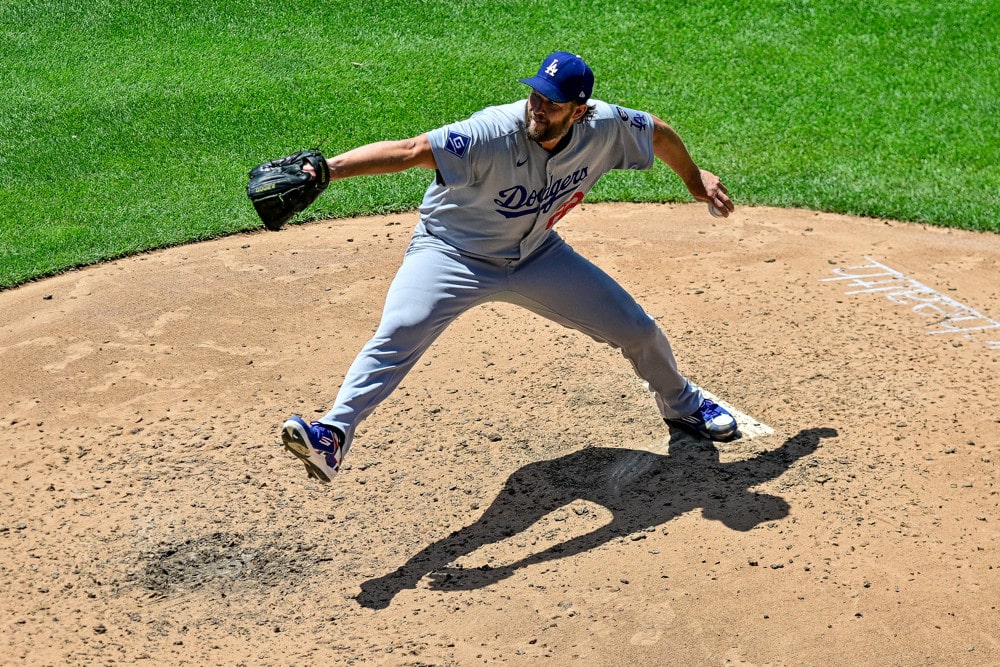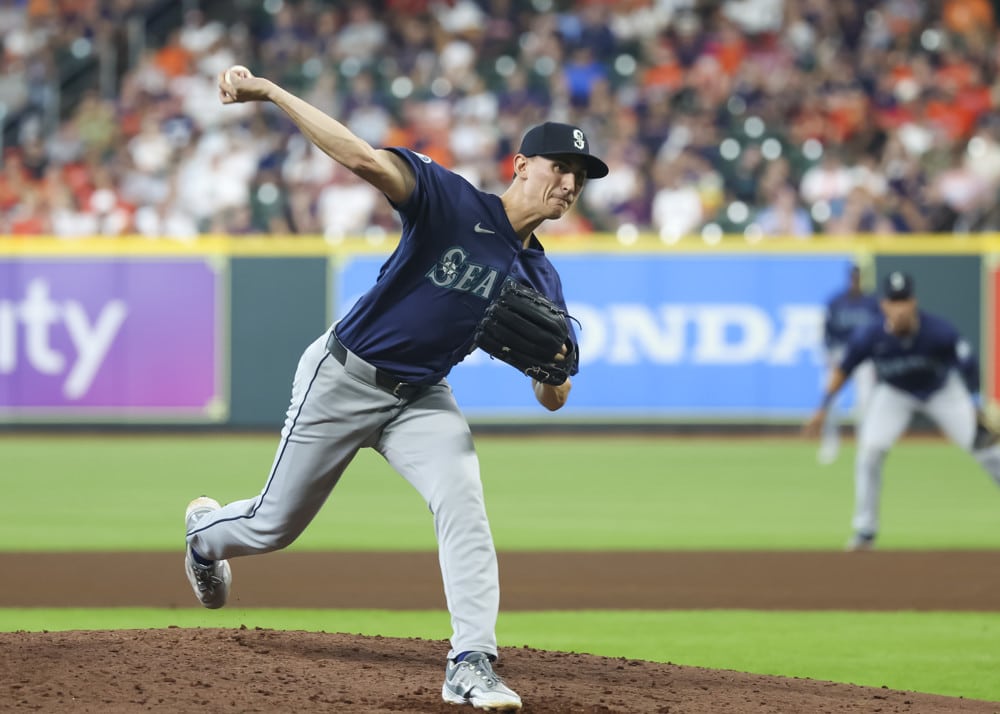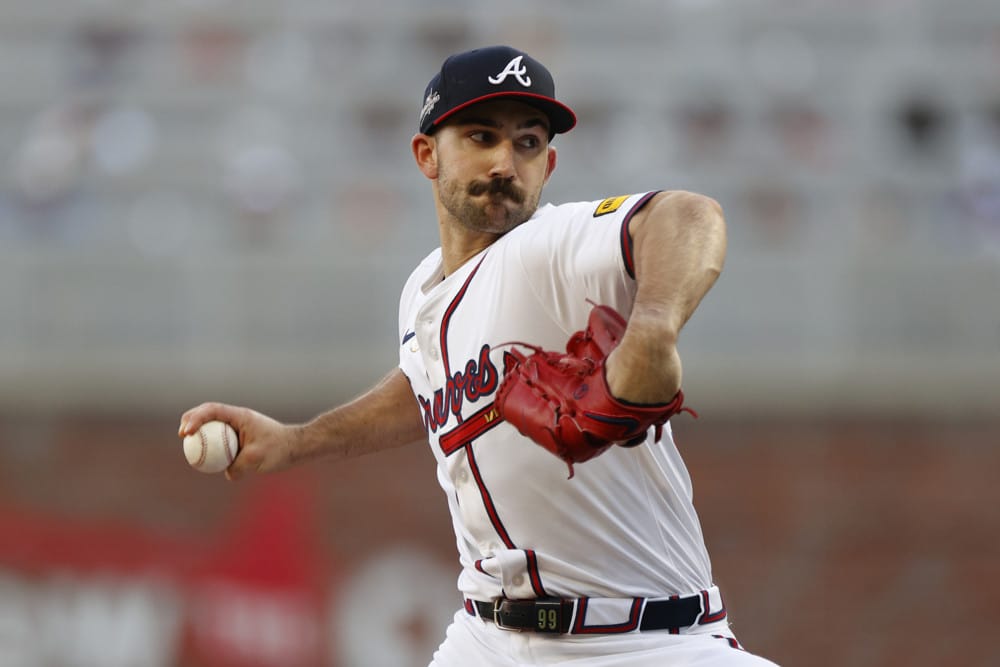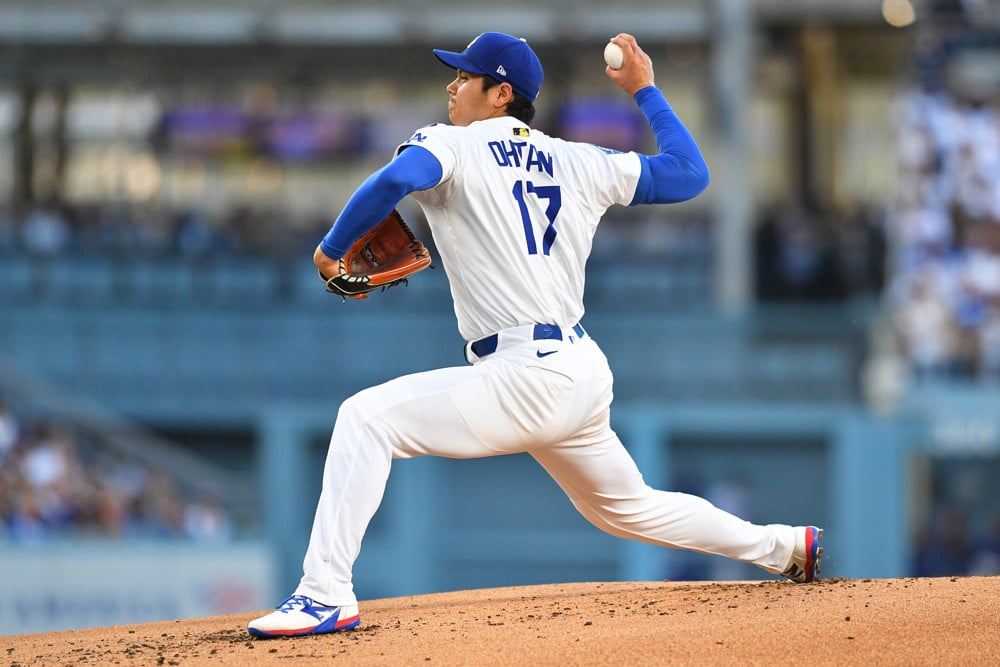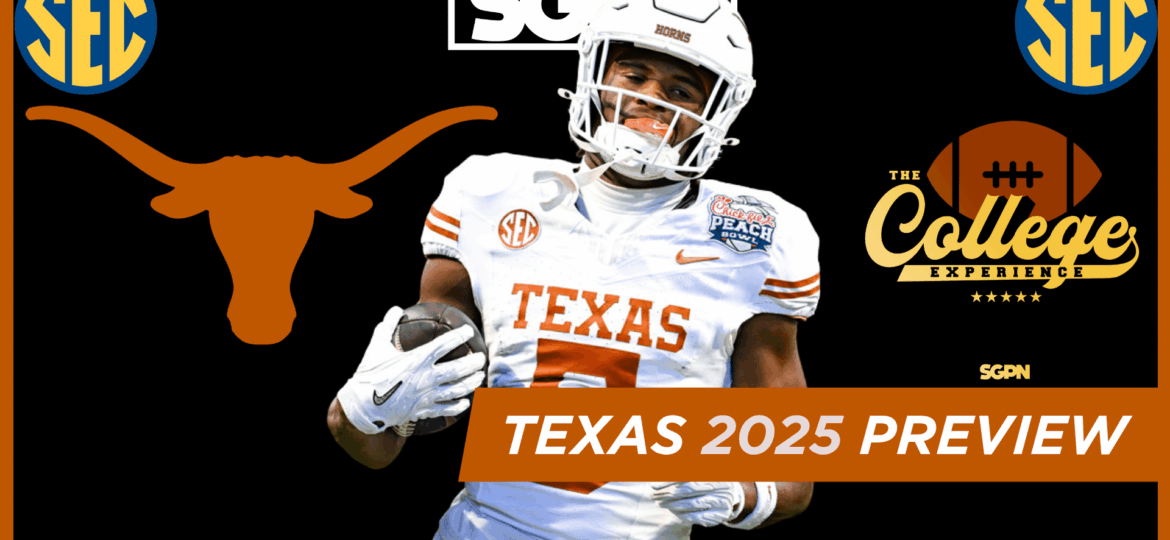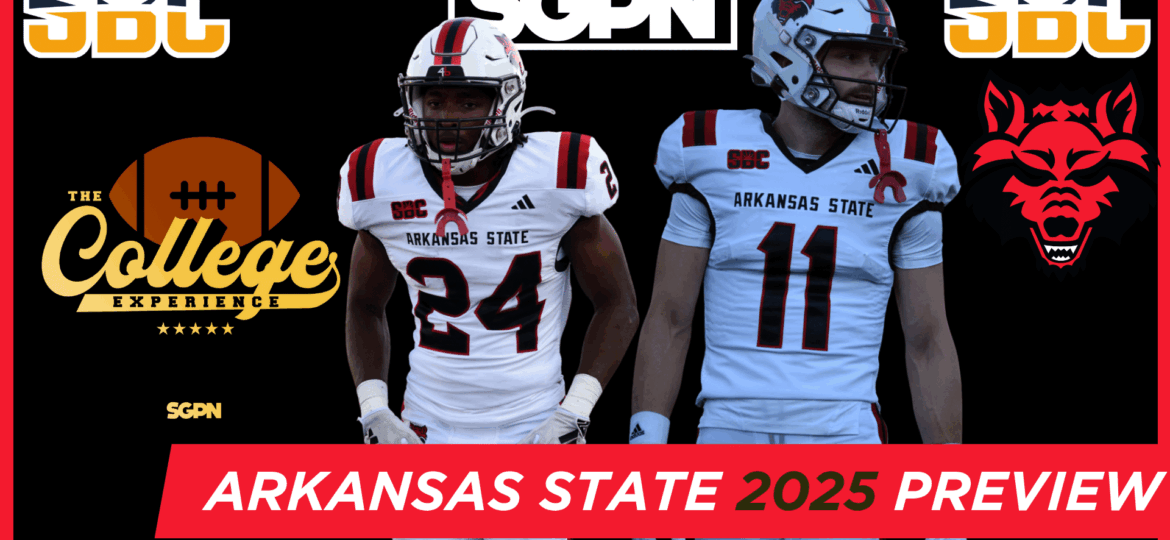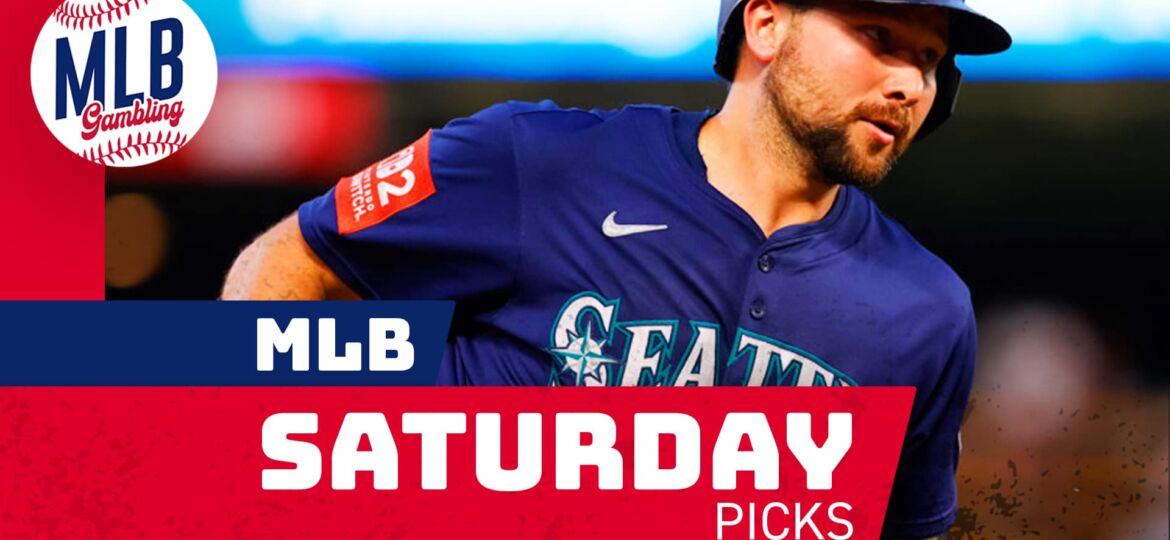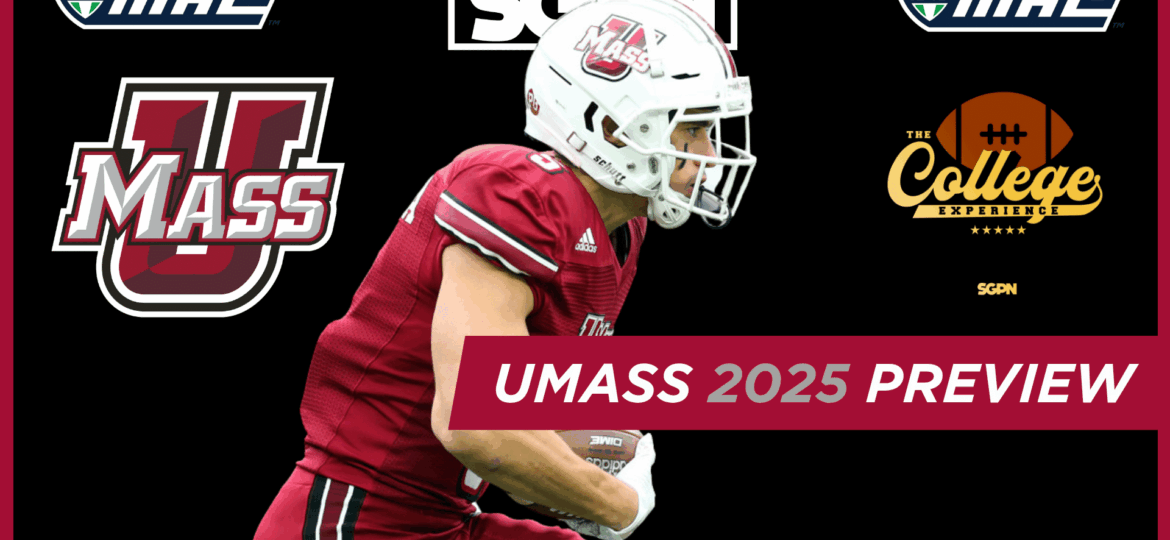With no past history to bank on, gamblers are left with little to preview how the 2022 US Open leaderboard will shake out. What are the best strategies to use when breaking down the skillsets that will matter most at the 2022 US Open? Here’s an in depth analysis of what to look for when putting together a betting card for the 2022 US Open.
For more detail on The Country Club at Brookline, click here.
US Open Preview – Relative Skillsets
Typically, a relative skillset chart by DataGolf will be shown to demonstrate what types of golfers fare well at a particular golf course. It’s derived from years and years of leaderboards from to provide a solid foundation of what it takes to do well there. But for the 2022 U.S. Open, gamblers will be left to guess for themselves what skills they should value most.
Breaking down relative skillsets is a tale of two stories. The first is what has historically been valued at U.S. Opens, particularly over the last few years. The second, however, is trying to marry that with the quirkiness and ancient style of golf we’ll see at The Country Club.
For this section, I’ve compiled a summary of every U.S. Open competed since 2009. I’ll provide a table showing how each winner was playing that year before the U.S. Open, as well as how the overall Top 10 was playing. Included in the tables will be their performance in every Strokes Gained category, as well as other relative statistics like driving distance, accuracy, green in regulation %, scrambling and Putting from 5-10 feet.
Let’s begin with a look at overall tee-to-green performance:
Historical Context: I’m not breaking any news that, at a golf tournament with the reputation of being the most demanding one in golf, the players who are very efficient tee-to-green flourish at U.S. Opens. Since 2009, the average total of strokes gained by players who finish inside the Top 10 at U.S. Opens leading up to the event is 0.80 per round. That’s also an average ranking of about 45th on the PGA Tour. It also should be noted that in the last four U.S. Opens, the importance of strong play tee-to-green leading up to the tournament has been maximized. In three of the last four years, the average strokes gained by Top 10 players leading into the tournament is over a stroke per round.
The same can be said about U.S. Open champions. The average U.S. Open was gaining 1.12 strokes per round tee-to-green on the field leading up to their victory. That’s an average ranking of about 26th on the PGA Tour. The lowest tee-to-green ranked player to win a U.S. Open since 2009 was Brooks Koepka, who ranked 67th entering the tournament. Overall, however, the winner has come from those who ranked at least inside the Top 50 on the PGA Tour. And in five of the last 9 U.S. Opens, the winner was ranked inside the Top 10.
It also should be noted the quality and age of who has won the tournament. The winner of the U.S. Open was ranked inside the Top 30 in the world in the last eleven events. And the winner has been under the age of 26 only three times since 2000. One was Tiger Woods, who had already won two majors by the time he was 25. Another was Rory McIlroy and took place at Congressional, considered an outlier U.S. Open venue and became a driving contest. The other was Jordan Spieth, who had just won the Masters a few months prior. Otherwise, premium players with ample professional golf experience have taken down the title.
Applying to Brookline: The quirkiness of Brookline might throw a monkey wrench into things. This isn’t a golf course that one can mindlessly plod around. Careful thought and precision is needed to navigate all 18 holes. However, those who are the most efficient tee-to-green will have the best tools to survive over the course of four rounds. When picking a winner or high placed finishers, target someone who is at least inside the Top 50 on the PGA Tour in Strokes Gained Tee-to-Green. You also should be targeting someone inside the Top 30 in the world and at least 26 years of age, based on historical patterns. And if you’re targeting someone outside of that, there better be a damn good reason why.
But not every player has the same strengths tee-to-green as others. Some particular skillsets will be favored. Let’s dive deeper and analyze which specific components tee-to-green has been favored at U.S. Opens, and whether that can be applied to this year’s tournament.
US Open Preview – Off-the-Tee
Historical Context: There are very few USGA venues that set up easy off-the-tee for the players. And that’s reflected in the types of players who have finished well at the U.S. Open in recent times. Since 2009, the average strokes gained off-the-tee per round of players who finished inside the Top 10 leading up to the tournament was 0.34, or about 53rd on the PGA Tour. The same can be said by those who have won the tournament. The winners of the U.S. Open have ranked inside the Top 20 on the PGA Tour in Strokes Gained Off-the-Tee in 10 of the last 13 U.S. Opens.
Everyone has always said that you must hit the fairway to do well at a U.S. Open. Conceptually, it’s true. But the ability to crush it off-the-tee has shown to be a huge advantage in recent U.S. Opens. Distance has massively increased its importance as players have changed the way they attack golf courses. Never before in the history of golf have players been as long off-the-tee as the ones that will play the 2022 U.S. Open. And they’ve used that length to gain an edge on the field. More and more longer players off the tee have populated Top 10’s at U.S. Opens over the last four years, as shown in the table above.
Accuracy has still mattered to some degree, although it has been on a case by case basis. Players who had a little more accuracy off the tee (or didn’t put themselves in such trouble that they couldn’t get to the green in regulation) typically tended to do better on the shorter U.S. Open venues and the most recent one, Torrey Pines. The shorter venues make sense why they favored more accurate players. That tended to be of a more positional, plodding environment off the tee where you had to miss in the right areas. These venues, such as Pebble Beach, Oakmont and Merion, all were heavily defended with thick penal rough. And as for Torrey Pines, all the holes were pretty straight out in front of the player. There weren’t any shortcuts off the tee one could make. Therefore, the goal was to hit it as long and straight as you could and avoid its penal rough.
Where accuracy didn’t seem to matter were golf courses that either became a driving contest and heavily favored a long hitter. Those tended to be Winged Foot, Erin Hills, Chambers Bay, Pinehurst, Congressional and Bethpage Black. Chambers Bay and Erin Hills featured pretty wide fairways, and therefore made it easier for players of various degrees of accuracy off the tee the ability to play from the fairway. Pinehurst features no rough and sandy waste areas off the fairways. Hitting into them is a luck box – either the ball could be perfectly playable or behind an unplayable plant. Congressional and Bethpage Black got a billion inches of rain dumped on it, and the long courses played closer to 7,800 yards for everyone. Naturally, longer players who hit it as far as they could off the tee had the advantage. And it was almost impossible to hold fairways at Winged Foot with how firm and narrow the fairways were. As such, all that mattered was how far one could bomb it and hope for a good lie for the approach shot.
Applying to Brookline: Brookline will play at only 7,254 yards. That is certainly on the shorter end of the spectrum of recent U.S. Open setups. And eyeballing what worked at most of the shorter venues, those with the most success did possess some semblence of accuracy off the tee. Or at the very least, the ability to not miss so badly that they couldn’t recover to hit the green in regulation.
However, do we still need to target those with some length? Probably yes, but elite length probably won’t be needed. As shown above, there’s quite a few awkward tee-shots where mindlessly bombing down the fairway isn’t the best strategy. Players who will be successful at Brookline will have the ability to properly shape their tee shot to the optimal side of the fairway so they either have the best angle to the green, or can avoid all the trouble. Accomplishing this doesn’t require elite length.
However, Brookline is expected to received significant rain this week. This will artificially lengthen the golf course because players won’t get a ton of roll off the tee. It also will make hitting out of the lush ryegrass rough a significant challenge. Conditions such as these always will favor a longer hitter with club head speed fast enough to hack out close to the green, as well as the ability to have shorter approach shots into the small greens of Brookline.
In terms of accuracy, I don’t foresee this tournament to be one with impossible to hit fairways, especially if they’re softer. Most landing zones at Brookline are between 30-35 yards wide. While narrow, they wont’ be impossible to hit and stay in the short grass. And because one has to have good control to shape shots to the optimal landing zones at Brookline, consider targeting players who have decent rankings in Good Drive % too. Like the shorter U.S. Open venues before it, expect those who fare well in that statistic leading up to the tournament to do well at Brookline.
US Open Preview – Approach
Historical Context: Iron play is typically regarded by gamblers as the most important stat to look at to handicap a tournament. But that hasn’t always been the case for U.S. Opens. Historically, the U.S .Opens that basically turned into a driving contest produced leaderboards where elite iron play leading up to the tournament wasn’t as essential. This was the case at places like Erin Hills, Chambers Bay, Congressional and Bethpage Black. As discussed in the last section, those tournaments quickly devolved into a contest of who could hit it the best with their driver.
There also are a few players recently who ranked horribly in approach shot statistics, but given the course conditions still won the tournament. As mentioned above, the 2020 U.S. Open at Winged Foot featured nearly impossible to hit fairways. Not only did it turn into a contest of who could hit it the farthest, but who also was strong enough to hack out of the penal rough to either on or near the green. Bryson DeChambeau is the best at doing that. As for Brooks Koepka, his rise to victory came for two different reasons. At Erin Hills and Chambers Bay, the greens were huge and everyone was hitting from the fairway. It gave players a much wider margin for error. And as for Shinnecock Hills, the greens were extremely difficult to hit in regulation because of how firm they were, despite a high percentage of approach shots coming from the fairway. That year turned into a bit of a scrambling contest, something Brooks is very good at.
Over the last three U.S. Open venues, however, overall Top 10’s featured most of the best iron players in the PGA Tour. The average ranking of all the Top 10 players in the last three U.S. Opens is about 43rd. And considering the quality of player that has been dominating the last three U.S, Opens, it’s no surprise that these players ranked highly in most iron play statistics leading up to the tournament. In addition, in most US Opens on shorter golf courses, players with good iron play tended to do better overall on the leaderboard. This is seen at venues like Pebble Beach, Merion, and the Olympic Club.
Applying to Brookline: As mentioned many times, Brookline has a shorter U.S. Open setup and features tiny greens. Only the greens at Pebble Beach can be called smaller than Brookline’s is. And it happened to be that at those two US Opens, those featured leaderboards jam packed with elite iron players at the top of it. Furthermore, other shorter venues such as Olympic Club and Merion heavily favored tremendous iron play. And Torrey Pines, also a golf course with smaller greens, heavily favored great iron players. As such, expect this U.S. Open to feature several strong iron players at the top of the leaderboard once again.
Scrambling
Historical Context: Scrambling abilities is a difficult one to assess at US Opens. Some years it was incredibly important for how the Top 10 shaped up. Other years, it wasn’t a factor at all. Good scramblers tended to do well at Torrey Pines, Shinnecock Hills, Erin Hills, Chambers Bay, Merion and the Olympic Club. It was a mixed bag at places like Winged Foot, Pebble Beach, Oakmont and Bethpage Black. And it mattered very little at Pinehurst and Congressional.
There’s not a whole lot of correlation to any of those situations between the golf courses, particularly the ones where it was a necessity. That group features both incredibly long and short golf courses. It also features golf courses with big and small greens, and ones with tight lies and thick rough around them. Plus, there were varying degrees in which the field got up and down from off the green. Shinnecock Hills, Chambers Bay and Merion featured very low scrambling rates. Torrey Pines and Erin Hills featured very high rates.
One thing is clear from those who’ve won the US Open, though. It’s a wide spectrum of abilities. Only four of the last 13 US Open champions ranked inside the Top 30 in Strokes Gained – Around-the-Green leading up to the US Open. And five champions ranked well outside the Top 100.
Unlike the last two categories, there seems like there’s very little rhyme or reason why good scramblers overall had the edge in certain years, while in other years it didn’t. If anything, it could be more important at places that feature significantly undulated greens. That seems to be the most common trait between places like Erin Hills, Chambers Bay, Merion, Olympic Club, Shinnecock Hills and Torrey Pines.
Applying to Brookline: Brookline shares similar around the green characteristics of the following venues:
- Pebble Beach
- Torrey Pines
- Winged Foot
- Oakmont
- Merion
- Bethpage Black
- Congressional
Pebble Beach and Torrey Pines are the best comparisons because both those venues, as well as Brookline, featured small greens surrounded by thick rough. The other venues only share the common characteristic of being surrounded by thick rough.
As described above, there’s little correlation with any of those venues when it mattered how well one was scrambling ahead of the US Open. But as hinted earlier, it could be due to the severe undulations of the greens in those particular US Opens. While the outlier was Winged Foot, the conditions tee-to-green only allowed players who excelled with driving distance from competing. At these other venues, it was a little fairer.
While Brookline will be demanding, it should behave more fair than somewhere like Winged Foot. And because the greens at Brookline are significantly undulated, you can expect scrambling to at least be somewhat relevant this week. But overall, this is probably the least important predictive statistic handicappers can utilize this week. Consider it the cherry on top of the sundae of justifying a pick.
Putting and Other Factors
Historical Context: Putting is another statistic that hasn’t had a constant theme to it over the years. However, at least recently it seems as though more and more good putters have littered the Top 10’s at US Opens. Most of the years where putting skills leading into the tournament was completely random happened before 2016. Since then, most Top 10’s saw an average ranking in Strokes Gained – Putting ahead of the US Open under 70th.
Winners, however, have come from all walks of life. Five of the last 13 US Open winners ranked inside the Top 30 in Strokes Gained – Putting ahead of the US Open. The same number of players ranked outside the Top 75, including four outside the Top 100.
In eight of the last nine US Opens, however, it seems to have been a somewhat necessary skillset for those who would ultimately have a good finish. Since 2014, of everyone who qualified for PGA Tour stats leading up to the tournament, 72.3% of all Top 10 finishers were at least inside the Top 100 in Strokes Gained – Putting. The only time putting was a complete crapshoot was Chambers Bay in 2015. And that was probably because the putting surfaces were terrible. But excluding this event, only 19% of those who finished inside the Top 10 were losing strokes putting on the season. It should be noted, however, that Gary Woodland, Martin Kaymer and Justin Rose all were losing strokes putting on the season before winning the US Open.
Many people utilize putting from 5-10 feet for handicap purposes. The rational is that, particularly on slick and undulating greens, balls will run far past the hole and set up uncomfortable par putts. While the logic behind it is sound, the predictive power of that statistic hasn’t always been very good. While it’s been a crucial trait of those who finished inside the Top 10 in three of the last four tournaments, overall it’s been a pretty volatile trait since 2009.
In fact, it mattered and didn’t matter at the same venue! Performance putting from 5-10 feet was a common trait for those who finished inside the Top 10 at the 2010 US Open at Pebble Beach. But in 2019, it didn’t matter at all.
One explanation for when it mattered most is in the firmness of the greens. Where it’s mattered the most (at least in terms of % conversion) is Torrey Pines, Winged Foot, Shinnecock Hills, Oakmont, and the 2010 US Open at Pebble Beach. In four of these five venues, the greens were incredibly firm. And where it’s mattered the least was places like Merion, Erin Hills, the Olympic Club, Pinehurst, Congressional, Bethpage Black and the 2019 US Open at Pebble Beach. With the exception of Pinehurst all these venues were softened up either through rain or a marine layer keeping moisture in the golf course.
Lastly, there’s been a strong trend that players who avoid bogeys overall tend to do well at US Opens for the last few years. This is kind of a low hanging fruit stat, especially considering how talented the players that have comprised some of these recent leaderboards are. Better players make fewer bogeys. It’s not rocket science. It might be useful to use for lesser players who might be good DFS plays, but it’s not really worth trying to use that stat to handicap the favorites.
Applying to Brookline: The Bentgrass/Poa greens will be very slick to putt on. Between the green speeds and the undulations, it’ll be a difficult surface to try and get the ball into the hole. That’s similar to places like Winged Foot, Oakmont and Shinnecock Hills. A lot of really good putters finished inside the Top 10’s on those leaderboards. At the very least, target someone who’s at least inside the Top 100 in Strokes Gained Putting heading into the tournament. It’s not a pre-requisite at all, but it helps and continues the trend we’ve seen for the last nine years.
In terms of Putting from 5-10 feet, while logically I want to agree with the conclusion that it matters, I have enough evidence that when greens are softer it hasn’t mattered as much. Maybe that’s allowed players to get a little better spin on balls to stop it a little closer to the hole on chip shots. And Brookline will be getting some rain this week. As such, I’m not going to worry too much about that statistic.
Lastly, while I’ll incorporate bogey avoidance into my handicap, I’m only going to break ties with it with players down the card. It’ll be the ones I’ll be looking to target for value DFS plays or Top 20 and 40 bets. But otherwise, it’s not a very useful stat to refer to with the favorites because, chances are, almost all of them rank highly in this stat.
So, in summary, what am I valuing this week (in order of importance):
- Tee-to-green efficiency – Players who are inside the Top 50 in this stat heading into the tournament automatically move up my priority list (unfortunately, this will be a popular opinion).
- Off-the-tee performance – I’ll always break ties with a longer player, but I don’t think elite length will be needed this week. I’m more concerned about looking for efficient players with at least above average length (approximately 70th or better in driving distance). In addition, because of the quirky tee shots and the necessity to place the ball in optimal landing zones at Brookline, performance in stats like Good Drive % is also important.
- Iron Play – Elite iron players have fared best when the US Open golf course featured smaller greens. Brookline is no exception. Strong iron play is a huge edge this week.
- Putting – At bare minimum, shy away from players who lose strokes putting heading into the tournament. While you don’t have to exclusively target elite putters, the ability to at least gain strokes on the field putting helps, especially on the slick undulating greens at Brookline.
- Scrambling – Sometimes at venues with thick, penal rough around the green, scrambling can be a bit of a luck box. If a great player draws a horrible lie, they’ll be hard pressed to get the ball close to the hole. Given that better scramblers have tended to do better at US Opens featuring severely undulated greens, it’s not a stat I can completely ignore this week. However, it cannot be the primary reason for choosing someone. Use it as the cherry on top of a justification or to break ties.
Using these strategies, you can expect to put together a solid 2022 US Open betting card or DFS lineup.




